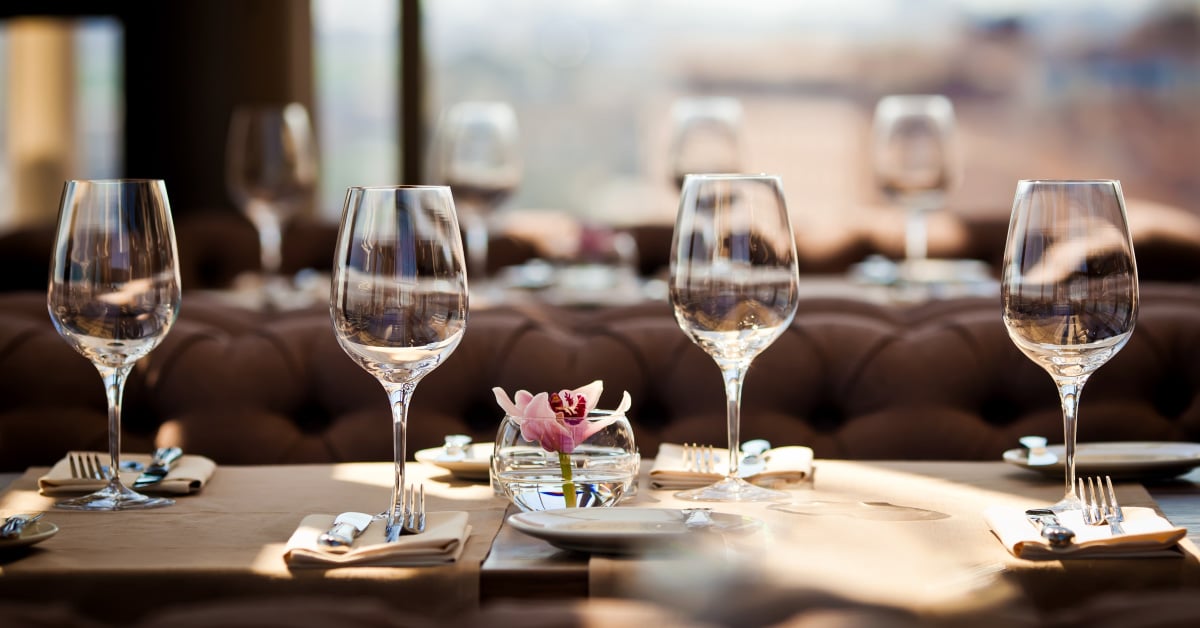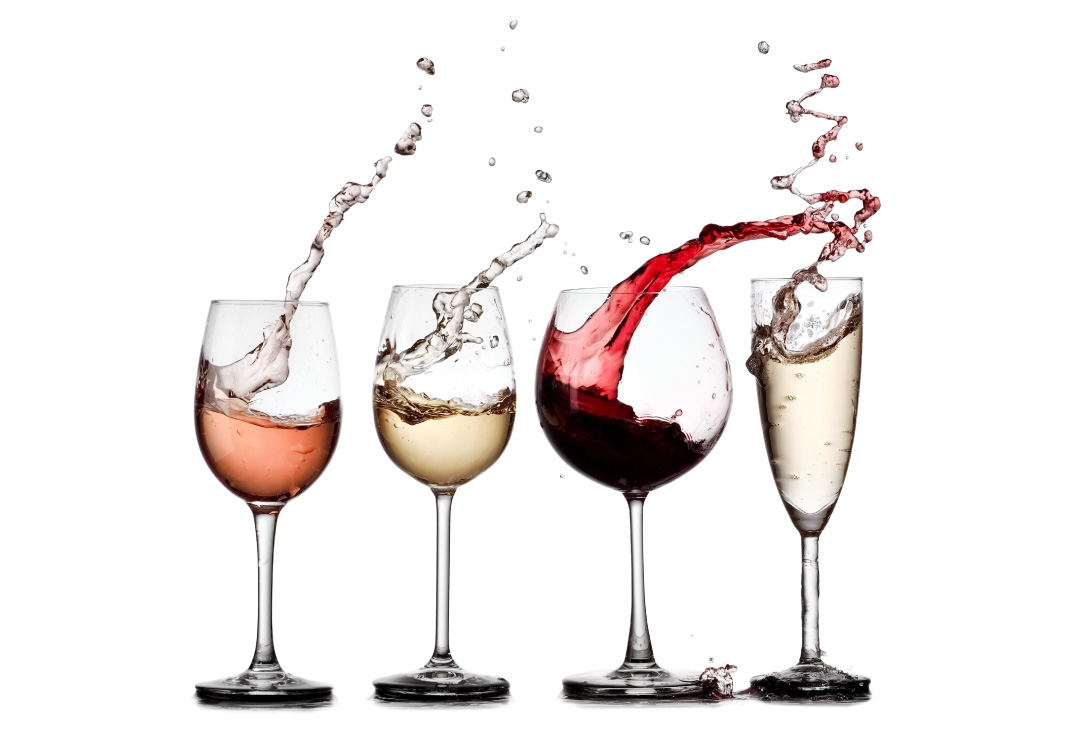Etiquette 101: The Why of Wine Glasses

Your heart is beating fast. You’re starting to sweat. You feel the anxiety slipping in. Your nerves are going into overdrive. Your boss has just invited you to a fancy event, and part of you is excited, but the other part is wrestling with a nervous panic.
You imagine the table setting at dinner…an array of forks, spoons, knives, plates of various sizes, a variety of wine glasses. What if you pick up the wrong spoon and embarrass yourself? How do you know which glass to use? What if you say the wrong thing?
Being nervous in this kind of situation is natural. Most of us didn’t grow up following the rules of formal etiquette. We learned basic manners, but we didn’t grow up attending a stream of gala events or luncheons with VIP dignitaries. The good news is that the basics of formal etiquette are not difficult to learn.
If you’re not familiar with the customs of high society scenarios, the rules might seem random or arbitrary. In fact, the “rules” are often very logical. Understanding the reasoning behind these customs makes fitting in simple.

Understanding the Types of Wine Glasses
Wine appreciation occupies an important place in high society. And when better to appreciate fine wines than a celebration or important event? In these kinds of prestigious events, you’re likely to encounter a variety of glassware. The Wine Glass Cheat Sheet and explanations below will help you understand how various glasses are designed differently for savouring the distinct characteristic of various wines.
 Red Wine Glasses
Red Wine Glasses
The biggest difference between red wine glasses and white wine glasses is that glassware for red wine tends to have a larger bowl. Not only is the bowl larger, but the shape is wider or more balloon-shaped than a white wine glass. Red wines benefit from aeration. The contact with oxygen helps them to release their complex flavours and aromas. The larger bowl provides more surface area for the wine to come into contact with the air. This size and shape is also perfect giving the wine a good swirl in the glass, allowing you to release and fully savour the aromas.
White Wine Glasses
In contrast to red wines, white wines are served chilled. The bowls of white wine glasses are smaller than those of red wine glasses, and the sides of a white wine glass are steeper to minimise the amount of wine surface area that meets the air. The design of a white wine glass helps maintain the cool temperature of the wine and also allows you to savour its subtler flavours and aromas.
While red wines are known for their bold flavours, white wines are savoured for their nuance. The shape of a white wine glass is ideal for enjoying subtle and clean notes of citrus, light floral aromas and soft herbal aromas. This shape is also perfect for rosé wines.
When enjoying white or rosé wines, hold the glass by the stem rather than the bowl to avoid warming the wine with your body temperature.

Champagne Glasses
Tall, thin Champagne flutes provide the smallest amount of contact between the air and the surface of the wine. This design helps keep the wine nice and bubbly, preventing all the bubbles from being released too quickly and letting the wine go flat.
In addition, the tall shape of a Champagne flute provides the perfect sensual visual, letting the bubbles rise up the height of the glass.
Dessert Wine Glasses
Red wine glasses tend to have a large bowl. White wine glasses tend to be medium. Sweet desserts wines are best served in small glasses with a much lower volume. Why? It’s a simple matter of serving size. Dessert wines have higher alcohol content so serving sizes are smaller.
Beyond the Basics
The simple explanations above are all you really need to know to be completely at ease as a guest when it comes to wine glass differences. Just be aware that endless variations of each type do exist so don’t be surprised if you encounter them.
In fact, wine glass designs have varied across time and geography. In recent decades, the art and science of wine glasses have exploded. You can find glasses specialised for different wine varietals and types. For example, high-tannin red wines, such as Cabernet Sauvignon, are best served in glasses with large, tall bowls that allow more aeration and mellow the tannins and alcohol. A red wine glass designed specifically for Pinot Noir will have a large, wide bowl that allows even more oxygenation and lets you better savour the wine’s subtle floral notes. Many of these artful design differences are very new in the long history of wine. Don’t worry about understanding all these small details. A basic understanding of the major wine glass types will be all you need for almost every situation as a guest and many situations as a host.
The Benefit of Knowing Formal Etiquette

The key benefit of learning formal etiquette is that enables us to be comfortable in the environment of international high society. There are times in our life when we may have to, for work or social reasons, partake in events that require an understanding of etiquette procedures and the protocols to follow around important dignitaries.
Is knowing the difference between wine glass types absolutely required to participate in a formal event as a guest? No, not really. If you’re hosting an event and serving wine, it’s important information. If you’re a guest, not so much. The service team will take care of providing wine in the proper glassware. In many etiquette situations, you can simply follow the lead of others when you’re unsure what to do. However, knowing the differences between various glasses will help you feel more at home at the event.
This is the benefit of mastering formal etiquette rules: knowing the protocols enables you to be comfortable. You’re not spending all your mental energy trying to break some mysterious code. You’re not spending every moment in fear that you’re making a mistake or doing something embarrassing.
If you understand the design reasons behind basic glass shapes, you will be able to remember which glass is for which beverage type. The more strongly you understand etiquette, the less time you need to spend thinking about it. Knowing etiquette eliminates anxiety and calms your nerves. You can spend your time being social, networking, and otherwise making the most of the occasion.

Knowing etiquette is an equaliser. Instead of feeling out of place, you can feel at home. Learning the fundamentals of formal etiquette removes barriers to your success. Enjoy yourself at elegant events. Know that you belong there. Make a positive impression. By mastering the fundamentals of etiquette, you’ll open up a whole new world of ease and opportunity.
Cheers to your future success!
Master the Fundamentals of Etiquette
Learn the key rules of fine dining etiquette in a single weekend.
From hosting members of the British Royal Family to organising lavish celebrations for esteemed dignitaries, AIHM Expert Gavin Tiffin has had a storied career, often working in the highest echelons of society. On 30-31 March 2024, he teaches a special workshop on Fine Dining Etiquette.
Because this is a special session outside our regularly scheduled courses, availability is limited. Register now to secure your spot.



.png)